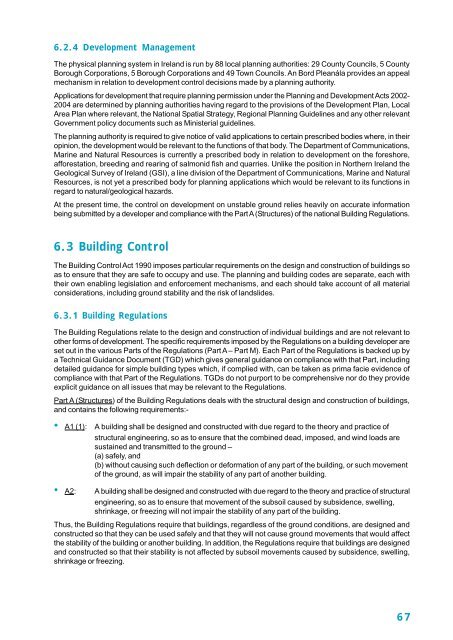to download report - Geological Survey of Ireland
to download report - Geological Survey of Ireland
to download report - Geological Survey of Ireland
- No tags were found...
You also want an ePaper? Increase the reach of your titles
YUMPU automatically turns print PDFs into web optimized ePapers that Google loves.
6.2.4 Development ManagementThe physical planning system in <strong>Ireland</strong> is run by 88 local planning authorities: 29 County Councils, 5 CountyBorough Corporations, 5 Borough Corporations and 49 Town Councils. An Bord Pleanála provides an appealmechanism in relation <strong>to</strong> development control decisions made by a planning authority.Applications for development that require planning permission under the Planning and Development Acts 2002-2004 are determined by planning authorities having regard <strong>to</strong> the provisions <strong>of</strong> the Development Plan, LocalArea Plan where relevant, the National Spatial Strategy, Regional Planning Guidelines and any other relevantGovernment policy documents such as Ministerial guidelines.The planning authority is required <strong>to</strong> give notice <strong>of</strong> valid applications <strong>to</strong> certain prescribed bodies where, in theiropinion, the development would be relevant <strong>to</strong> the functions <strong>of</strong> that body. The Department <strong>of</strong> Communications,Marine and Natural Resources is currently a prescribed body in relation <strong>to</strong> development on the foreshore,afforestation, breeding and rearing <strong>of</strong> salmonid fish and quarries. Unlike the position in Northern <strong>Ireland</strong> the<strong>Geological</strong> <strong>Survey</strong> <strong>of</strong> <strong>Ireland</strong> (GSI), a line division <strong>of</strong> the Department <strong>of</strong> Communications, Marine and NaturalResources, is not yet a prescribed body for planning applications which would be relevant <strong>to</strong> its functions inregard <strong>to</strong> natural/geological hazards.At the present time, the control on development on unstable ground relies heavily on accurate informationbeing submitted by a developer and compliance with the Part A (Structures) <strong>of</strong> the national Building Regulations.6.3 Building ControlThe Building Control Act 1990 imposes particular requirements on the design and construction <strong>of</strong> buildings soas <strong>to</strong> ensure that they are safe <strong>to</strong> occupy and use. The planning and building codes are separate, each withtheir own enabling legislation and enforcement mechanisms, and each should take account <strong>of</strong> all materialconsiderations, including ground stability and the risk <strong>of</strong> landslides.6.3.1 Building RegulationsThe Building Regulations relate <strong>to</strong> the design and construction <strong>of</strong> individual buildings and are not relevant <strong>to</strong>other forms <strong>of</strong> development. The specific requirements imposed by the Regulations on a building developer areset out in the various Parts <strong>of</strong> the Regulations (Part A – Part M). Each Part <strong>of</strong> the Regulations is backed up bya Technical Guidance Document (TGD) which gives general guidance on compliance with that Part, includingdetailed guidance for simple building types which, if complied with, can be taken as prima facie evidence <strong>of</strong>compliance with that Part <strong>of</strong> the Regulations. TGDs do not purport <strong>to</strong> be comprehensive nor do they provideexplicit guidance on all issues that may be relevant <strong>to</strong> the Regulations.Part A (Structures) <strong>of</strong> the Building Regulations deals with the structural design and construction <strong>of</strong> buildings,and contains the following requirements:-• A1 (1):A building shall be designed and constructed with due regard <strong>to</strong> the theory and practice <strong>of</strong>structural engineering, so as <strong>to</strong> ensure that the combined dead, imposed, and wind loads aresustained and transmitted <strong>to</strong> the ground –(a) safely, and(b) without causing such deflection or deformation <strong>of</strong> any part <strong>of</strong> the building, or such movemen<strong>to</strong>f the ground, as will impair the stability <strong>of</strong> any part <strong>of</strong> another building.• A2:A building shall be designed and constructed with due regard <strong>to</strong> the theory and practice <strong>of</strong> structuralengineering, so as <strong>to</strong> ensure that movement <strong>of</strong> the subsoil caused by subsidence, swelling,shrinkage, or freezing will not impair the stability <strong>of</strong> any part <strong>of</strong> the building.Thus, the Building Regulations require that buildings, regardless <strong>of</strong> the ground conditions, are designed andconstructed so that they can be used safely and that they will not cause ground movements that would affectthe stability <strong>of</strong> the building or another building. In addition, the Regulations require that buildings are designedand constructed so that their stability is not affected by subsoil movements caused by subsidence, swelling,shrinkage or freezing.67
















